The Importance of Metal Knife Magnets in Modern Kitchens
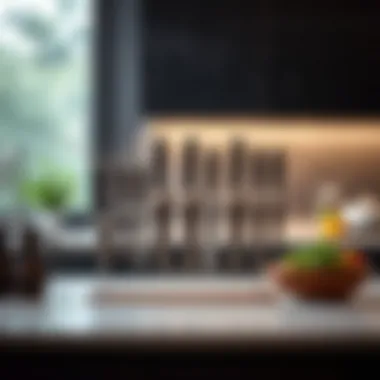
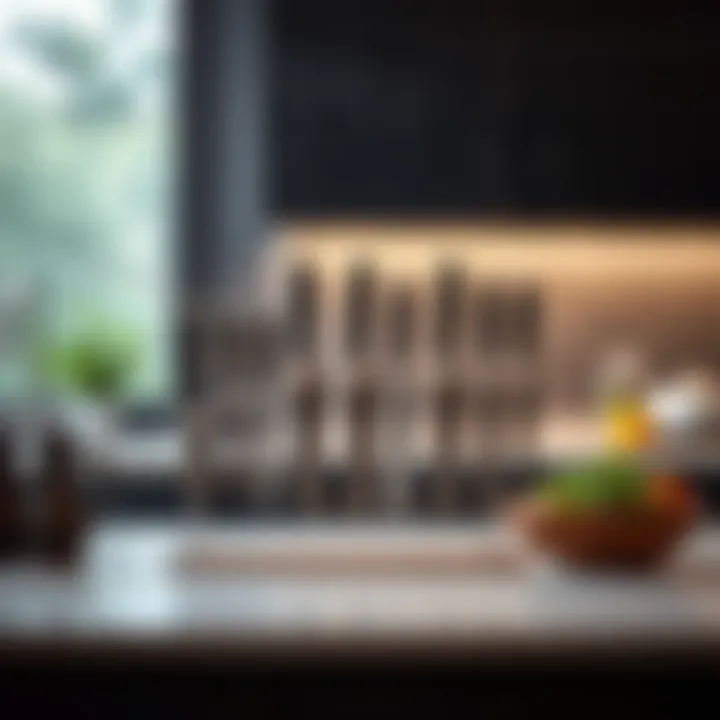
Intro
In recent years, the culinary landscape has undergone significant changes, reflecting not just new cooking methods but also a shift in how kitchens are organized. A notable player in this evolution is the metal knife magnet. These seemingly simple tools have emerged as essential elements in modern kitchens, serving both functional and aesthetic purposes. As we navigate through the intricacies of these kitchen magnets, we’ll uncover their multifaceted roles—from maximizing space to enhancing safety while providing a visual statement in home decor. This journey will also highlight the practicalities of installation, maintenance, and the latest trends surrounding their use.
Furniture Trends and Styles
Current Trends in Kitchen Design
Kitchens today have transcended their traditional role as mere cooking spaces. They now double as social hubs, where design intricacies meet functionality. Among prominent features, metal knife magnets have gained traction for their sleek appearance and practicality. Current trends lean towards open, airy kitchen designs that prioritize organization and accessibility. With an emphasis on minimalism and sophistication, these magnets complement various aesthetics, from rustic to contemporary, providing that finishing touch to the kitchen ambiance.
Popular Kitchen Styles and Their Characteristics
- Modern Minimalism
In minimalist kitchens, every item must serve a purpose—form meets function here. Metal knife magnets fit this philosophy well, keeping knives within reach without cluttering countertop space. Their clean lines and unadorned surfaces echo minimalist values. - Industrial Charm
Raw materials and exposed elements define industrial kitchens. Metal knife magnets harmonize with stainless steel appliances and wooden accents, enhancing the rugged yet sophisticated look unique to this style. - Farmhouse Feel
The farmhouse style brings warmth and comfort. Traditional wooden cabinetry paired with sleek metal knife magnets creates an appealing contrast, marrying rustic charm with modern utility. - Contemporary Fusion
Blending various styles is a hallmark of contemporary kitchen design. Metal knife magnets act as a bridging element here, integrating functionality within diverse decors effortlessly.
Buying and Maintenance Guides
Essential Tips for Purchasing Metal Knife Magnets
When considering a metal knife magnet, it’s essential to evaluate certain factors to ensure you make the best choice for your space:
- Length and Strength: Choose a magnet that can securely hold the number of knives you own, considering their weight and size.
- Material Quality: Stainless steel finishes often provide better durability and resistance to corrosion as compared to other materials.
- Installation Method: Some magnets are designed for wall mounting, while others are freestanding. Assess your kitchen layout and select accordingly.
Maintenance and Care for Metal Knife Magnets
Once you have installed your metal knife magnet, it is crucial to maintain it properly to ensure longevity:
- Regular Cleaning: Wipe down the surface with a damp cloth to prevent knife residue build-up—this keeps both the magnet and the knives in good condition.
- Avoid Moisture: Position the magnet in a dry area to prevent rust from developing. An ideal location away from direct humidity will prolong its life.
In the realm of kitchen organization, understanding the practical applications of tools like metal knife magnets can elevate not just functionality, but also the overall design of the space. As trends evolve and preferences shift, these innovative items stand as both useful tools and elements of style, encapsulating the essence of modern kitchen design.
Prelims to Metal Knife Magnets
Metal knife magnets have emerged as an indispensable accessory in modern kitchens, accentuating both functionality and aesthetics. These devices hold metal knives securely, allowing them to be displayed prominently without the risk of cluttering countertops or wasting precious drawer space. This introduction aims to illuminate the role these magnets play in contemporary culinary spaces, emphasizing their benefits and considerations. Utilizing knife magnets is more than a trend; they represent a shift toward more efficient kitchen organization while serving as an eye-catching design element.
Definition of Metal Knife Magnets
Metal knife magnets are typically strips made from ferromagnetic materials, designed to attach to walls or various surfaces in a kitchen. Equipped with powerful magnets, they securely hold metallic knives and other kitchen utensils. Unlike traditional knife blocks, which can take up counter space, these magnets offer a sleek solution. Available in various lengths and finishes, they can cater to an array of design aesthetics, from industrial to minimalistic décor. Furthermore, they are adaptable to any kitchen layout, whether spacious or compact, making them a practical choice for homeowners and chefs alike.
Historical Context and Evolution
Historically, knife storage involved cumbersome blocks, drawers, or even hanging racks, which had their own sets of drawbacks. Over time, as kitchen design evolved to embrace open-plan concepts, the need for more space-efficient and visually appealing solutions became apparent. The introduction of metal knife magnets can be traced back several decades, but they have gained significant traction in recent years as a preferred option for many culinary enthusiasts. With the rise of modern design philosophies prioritizing cleanliness and organization, metal knife magnets quickly adapted, merging utility with style. This evolution of knife storage reflects broader changes in culinary practices and household design, allowing for greater ease of access while showcasing a chef’s tools as part of the kitchen’s visual identity.
"Kitchen tools and accessories are no longer mere functional items; they have become integral parts of the home’s design narrative."
Types of Metal Knife Magnets
When it comes to kitchen organization, the type of metal knife magnet used can significantly impact both functionality and aesthetics. Understanding the different types available allows homeowners and designers to make informed choices that suit their specific needs. Each type has unique characteristics and benefits that can enhance not only the organization of knives but also the overall look of the kitchen space.
Material Variations and Their Benefits
Metal knife magnets can be made from various materials, each offering distinct advantages. The most common materials include:
- Stainless Steel: This material is known for its durability and resistance to corrosion. Stainless steel knife magnets not only hold knives securely but also are easy to clean, helping maintain a hygienic kitchen environment. Moreover, they add a sleek, timeless vibe to modern kitchens.
- Aluminum: Lighter than stainless steel, aluminum knife magnets are easy to install and often come in a variety of colors. While they may not provide the same level of durability against scratching, they can add a fun pop of color or a modern twist to kitchen decor.
- Wood: Wooden knife magnets typically feature a magnetic strip embedded within the wood. They offer a warm, inviting look and can blend seamlessly with cabinetry. However, they may require more care to prevent damage from moisture or heat.
The choice of material impacts both the functionality of the magnet and the overall style of the kitchen. For example, a stainless steel magnet could complement a sleek, modern design, while a wooden magnet might suit a rustic or traditional aesthetic.
Design Styles: Traditional vs. Contemporary
When selecting a metal knife magnet, the design style can play a crucial role in the kitchen’s decor.
- Traditional Styles: These often feature more ornate designs that focus on craftsmanship. A classic wooden knife magnet, for instance, may have intricate carvings or a polished finish that adds character to the kitchen. Such designs enhance warmth and familiarity, capturing the essence of traditional cooking spaces.
- Contemporary Styles: In contrast, contemporary knife magnets lean towards minimalism and clean lines. They are often designed to be functional without unnecessary embellishments. Stainless steel or clear acrylic are popular materials for a modern aesthetic. These magnets may also come in various shapes and sizes, allowing for creative displays that showcase not only the knives but also the user’s style.
Ultimately, the type of metal knife magnet chosen should reflect personal taste while aligning with the kitchen's overall design theme. Homeowners should think about both aesthetic and practical requirements in order to achieve a well-rounded solution that elevates their culinary space.
"The right knife magnet can transform your kitchen, making it a blend of functionality and style."
In the end, whether opting for a traditional or contemporary design, ensuring that the chosen magnet suits the kitchen’s functionality is key. Making an informed selection regarding the material and design of metal knife magnets will greatly enhance not only your organizational capabilities but also your home’s décor.
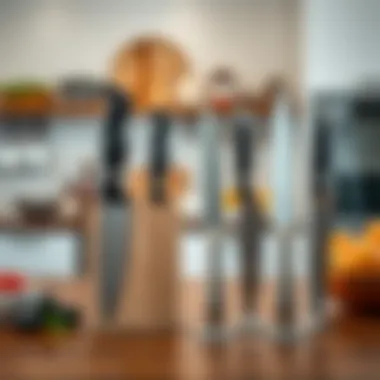
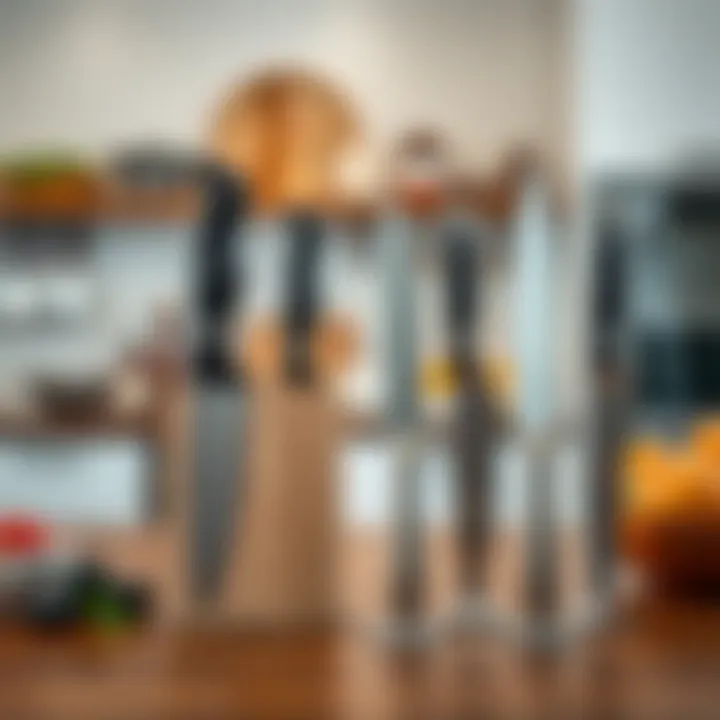
Benefits of Using Metal Knife Magnets
Metal knife magnets have carved out a significant niche in the world of kitchen tools, and it's not just by good luck. Their practical nature and versatile appeal make them a sought-after addition for any culinary space. Let's take a closer look at the benefits these magnets bring to modern kitchens.
Enhancing Kitchen Organization
In a bustling kitchen, organization can mean the difference between a smooth operation and chaos. Metal knife magnets are designed not only to hold knives but to transform the entire layout of one's workspace. Here’s why:
- Visibility: With knives displayed vertically, they are easier to spot. A quick glance can show you what you have, without rummaging through drawers or searching kitchen blocks.
- Accessibility: Unlike traditional storage, metal knife magnets allow for easy access. You won't have to dig through a jumbled drawer; simply reach out and grab the knife you need.
- Space-Saving: For those with limited kitchen space, these magnets can be a game-changer. They free up counter space and allow for a cleaner, more streamlined look, keeping everything in reach without cluttering your prep area.
- Flexibility: You can place these magnets wherever it suits you best – over a countertop, beside the stove, or even on a back wall. This adaptability contributes to customizing your kitchen's layout.
With the practicality of these magnets, organization becomes more intuitive and efficient. They turn the often mundane task of knife storage into a seamless component of your cooking experience.
Safety Considerations and Access
Safety is always a top priority in the kitchen, and metal knife magnets can enhance that safety in a few distinct ways:
- Stability: When mounted correctly, these magnets securely hold knives in place, reducing the risk of mishaps that come from knocked-over block storage or fallen knives in a drawer.
- Child Safety: For those with young children, magnet systems can be installed out of reach. Meanwhile, adults can access knives quickly and easily, streamlining the cooking process.
- Quick Retrieval: Speed is vital when handling sharp objects. With metal knife magnets, grabbing the right knife takes mere seconds, which is crucial when you’re in the heat of meal prep.
"A well-organized kitchen leads to better cooking. With metal knife magnets, your safety and efficiency rise hand in hand."
In short, improving accessibility while ensuring knife security provides peace of mind for any cook.
Aesthetic Appeal in Kitchen Decor
Beyond functionality, let's not overlook the role of aesthetics. Metal knife magnets offer a striking visual element that enhances kitchen decor. They come in various styles, complementing both modern and traditional designs. Here's how:
- Modern Look: Sleek and minimalist designs help create a contemporary kitchen vibe. Stainless steel magnets can bring a touch of sophisticated elegance and shine to your space.
- Rustic Charm: Even in a cozy, rustic setting, magnets can fit right in. Wood and metal combinations provide warmth and beauty, thus blending form and function seamlessly.
- Customization: Many designs allow for personalization. Some homeowners opt for magnet strips with unique finishes or embedded lights, adding an extra flair that reflects personal taste.
Using metal knife magnets thus goes beyond mere functionality; it enhances the visual narrative of your kitchen, giving it a polished, put-together feel.
Installation Techniques
Understanding the proper installation techniques for metal knife magnets is crucial for ensuring that they function effectively and enhance the overall kitchen experience. The process of installation might seem straightforward, yet it carries implications that can significantly affect safety, access, and aesthetic appeal. An appropriately installed magnet not only keeps knives secure but also showcases them beautifully, making them a functional piece of decor that adds character to your kitchen.
Preparing the Kitchen Space
Before diving into the installation process, you need to take a good, hard look at your kitchen space. Assessment is the name of the game here. Consider the layout and flow of your kitchen. Identify a promising spot that's within arm's reach during food prep but avoids cluttered areas.
A few tips to set the stage:
- Choose a Wall Section: Look for empty wall areas—this could be above your countertop or prep area. Avoid placing it in a corner or an area with heavy traffic where it might get bumped.
- Consider Electrical Outlets: Ensure you don’t block any outlets or overhead light fixtures with the magnet.
- Visual Appeal: Think about the sightlines when you enter your kitchen. It's not just about function; you want this to look nice.
By taking time to prepare, you're laying the groundwork for a flawless installation.
Step-by-Step Installation Guide
Once you've pinned down where you’d like to hang your magnet, it’s time to roll up your sleeves. Here’s a succinct guide to get you all squared away:
- Gather the Necessary Tools: You’ll need a drill, screws (often provided with the magnet), level, measuring tape, and possibly a stud finder.
- Measure Accurately: Use your measuring tape to find the perfect spot. Generally, a height of around 4 feet from the ground works well for accessibility. Mark where the screws will go.
- Align and Level: Position the magnet where you want it and use the level to ensure it's straight. Nothing screams amateur like a tilting knife magnet.
- Drill Holes: If you’re mounting it directly into the wall, drill holes according to the marks you've made. If you hit studs, that’s a win; if not, you'll need wall anchors.
- Mount the Magnet: Secure the magnet by attaching it with screws. Make sure it’s snug but don’t over tighten—strips of the magnet can be damaged.
- Final Check: After installing, give it a gentle tug before hanging knives on it. Ensure there’s no wobble.
Following this guide not only saves you from future headaches but also optimizes the usage of the magnet.
Common Mistakes to Avoid
Even the best of us can trip up during a DIY project. To sidestep common pitfalls, here are a few traps to avoid:
- Ignoring Wall Material: Know what your wall is made of. Installation varies if you’re dealing with drywall compared to tile or concrete. For example, you’ll need different screws or anchors for each type.
- Too Low or High Installation: Placing your magnet too low or too high can lead to unnecessary strain when grabbing a blade. Stick to that 4-feet guideline for best results.
- Not Checking for Level: Skipping the level check can land your knife magnet in a precarious and less useful position.
- Overloading the Magnet: Remember that your magnet has its limits. Loading it down with too many knives can lead to failure and potential accidents.
By learning from the missteps of others, you can ensure you don’t play the fool in your own kitchen renovation.
"Proper installation can turn a simple kitchen accessory into a seamless part of your culinary routine."
Maintenance and Care
Maintaining metal knife magnets is crucial for ensuring their longevity and functionality within your kitchen environment. These sleek tools, often the unsung heroes of kitchen organization, require not just installation but also consistent care. Keeping a close eye on the upkeep of these magnets can greatly enhance your culinary space's safety, aesthetic appeal, and overall efficiency. Regular maintenance practices allow them to remain beautifully functional, contributing to an organized kitchen that feels both inviting and practical.
Regular Cleaning Practices
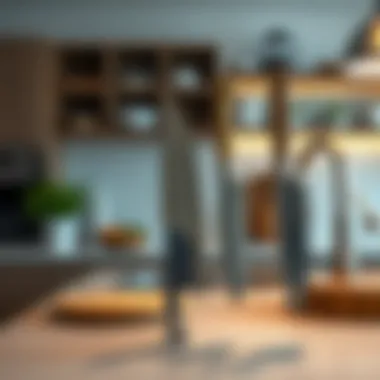
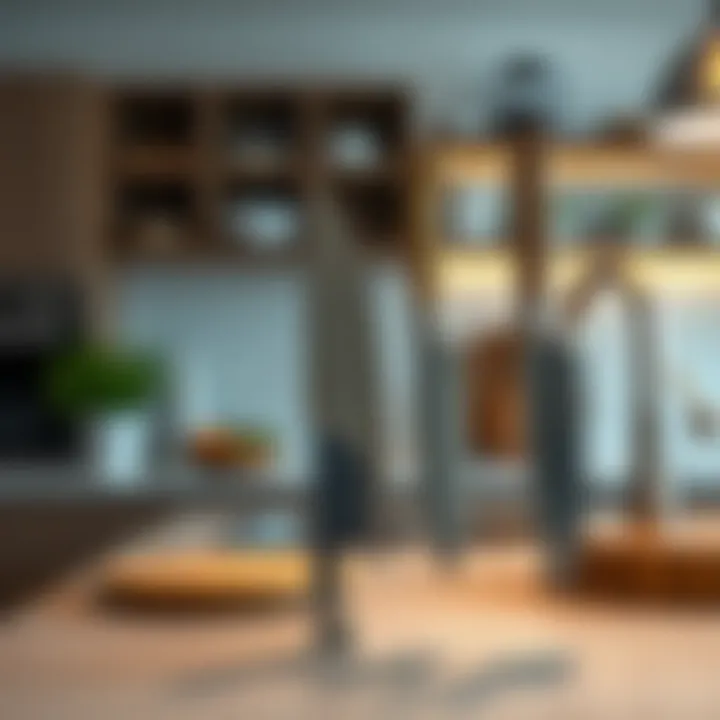
To keep your metal knife magnets gleaming and in top working order, cleaning should be part of your regular kitchen routine. Here are some practices to ensure their longevity:
- Use a Soft Cloth: A simple microfiber cloth is effective in removing dust and debris. Avoid abrasive materials, as they might scratch the metal surface.
- Mild Soap and Water: Occasionally, use a mixture of mild soap with warm water for a more thorough cleaning. Just dampen the cloth; don't soak it, as excess moisture can lead to rust spots.
- Dry Immediately: After cleaning with water, be sure to dry the magnets right away. Leaving moisture can create unwanted conditions for corrosion.
- Spot Check: Upon using knives, often small food particles may cling. Spot check the magnet after heavy use, particularly after cutting meats or oily foods. Just a quick wipe can prevent buildup.
Incorporating these cleaning habits can help maintain both the effectiveness and aesthetic appearance of your magnets, ensuring they remain a focal point of your kitchen.
Long-Term Care Solutions
Looking at the long game, several strategies can support the longevity of your metal knife magnets:
- Placement Considerations: Ensure that the magnets are installed in a dry area away from direct heat and moisture. This avoids warping or rusting, especially from kitchen activities involving steam or excessive heat.
- Periodic Inspections: Schedule regular inspections of the magnets. Look for any signs of wear, detachment, or distress in the hardware. Addressing issues early can prevent more significant problems down the line.
- Consider Seasonal Cleaning: At the start of each season, take the time to do an in-depth cleaning. This can involve removing the magnet entirely to clean both the surface it’s attached to and the underside of the magnet itself.
- Protective Coating: If rust is a concern, consider applying a food-safe protective coating that can be periodically reapplied. This protective layer can fend off moisture and keep the magnetic surface in fine form over time.
Maintaining metal knife magnets does not have to be a tedious endeavor. With conscious practices woven into your regular cleaning routine and a few thoughtful long-term strategies, the utility and brilliance of these kitchen assets can be enjoyed for years to come.
"A little foresight goes a long way in keeping your kitchen tools in parade-ready condition."
For more tips, check out Wikipedia on Knife Care and Reddit's DIY Kitchen Tips.
Consumer Preferences and Trends
Understanding consumer preferences in the realm of kitchen accessories, especially metal knife magnets, serves as a mirror to the evolving tastes and demands of modern homeowners. This topic sheds light on what consumers value, which can inform both manufacturers and retailers about the best ways to cater to their market.
Market Trends in Kitchen Accessories
The landscape of kitchen accessories is ever-shifting, shaped by lifestyle changes, technological advancements, and a growing emphasis on aesthetics and sustainability. In recent years, there has been a noticeable swing toward minimalistic designs that marry functionality and visual appeal. Metal knife magnets have become a preferred choice for many, as they not only conserve counter space but also create a display of knives that look striking on the wall.
Key trends currently shaping the market include:
- Sustainable Materials: With increased environmental awareness, many consumers are opting for knife magnets made from recycled metals. This reduces the carbon footprint and appeals to eco-conscious buyers.
- Customization: Buyers are increasingly looking for personalized options. From bespoke lengths to custom finishes, tailored knife magnets can suit unique kitchen styles and personal tastes.
- Smart Technology Integration: Some manufacturers are incorporating features like built-in lighting to showcase knives better or even smart systems that keep track of inventory. While this is still in its infancy, it speaks to a broader trend of blending functionality with cutting-edge tech.
These trends not only offer insight into consumer behavior but also demonstrate how manufacturers adapt their products to remain relevant.
Feedback from Users
User feedback can often provide an illuminating perspective on the real-world application of metal knife magnets. Many consumers have expressed satisfaction with their decision to incorporate these practical accessories into their kitchens. They appreciate aspects such as easy access to their knife collections and the visual enhancement it brings to their space.
Some common remarks from users include:
- Space Efficiency: "I've reclaimed valuable countertop real estate! No more bulky knife blocks taking up space."
- Visual Appeal: "It’s like art in the kitchen! I love how it showcases my knife collection."
- Safety: "With my knives out of drawers, I am less prone to accidents. They’re easy to grab, and I can keep an eye on the kids!"
However, it’s worth noting that not all feedback is glowingly positive. Some users mention concerns like the strength of the magnet, particularly for larger knives, or the potential for damage to knife finishes due to constant contact with the magnet. Addressing these positives and negatives is crucial for both consumer knowledge and for manufacturers looking to improve their products.
Overall, understanding these consumer preferences and trends can provide valuable insights for stakeholders in the kitchen accessory market, especially in guiding future designs and marketing strategies.
"Consumer feedback acts like a compass, pointing to the path for organizations hoping to thrive in today's market."
By keeping a pulse on what customers want and responding to feedback accordingly, the landscape for metal knife magnets—and indeed all kitchen accessories—can evolve in ways that are both progressive and alignment with consumer values.
Comparison with Other Knife Storage Solutions
When it comes to organizing knives in the kitchen, several options are available. Metal knife magnets, knife blocks, and drawer storage solutions each offer unique benefits and considerations. Understanding these differences can help homeowners, designers, and culinary enthusiasts make informed choices that fit their culinary spaces and lifestyles.
Knife Blocks vs. Knife Magnets
Knife blocks have been a staple in kitchens for decades. They provide a secure storage solution that typically allows for easy access to a variety of knives, from large chef's knives to petite paring knives. The main advantages of knife blocks include:
- Stability: They offer a sturdy way to store knives, which minimizes the risk of accidents or blade damage.
- Variety: Most knife blocks come with designated slots and can accommodate a range of knife sizes and types.
- Accessibility: Knives are usually within arm's reach, reducing the time spent searching for the appropriate utensil during cooking.
However, knife blocks are not without their downsides. They can take up significant counter space and, if not cleaned regularly, can become a breeding ground for bacteria due to crumbs and moisture. Also, there’s a visual aspect to consider: not all knife blocks offer the style that complements modern kitchen aesthetics.
In contrast, metal knife magnets are increasingly becoming the go-to option for many home cooks. The benefits they provide include:
- Space Efficiency: Magnetic strips can be mounted on walls, freeing up precious counter space.
- Visibility: Having knives displayed on a magnet strip allows for easy identification and access, making cooking more streamlined.
- Design Flexibility: Magnetic strips come in various designs, from sleek stainless steel to more decorative wood finishes, allowing them to enhance kitchen decor.
- Easy Cleaning: Surface cleaning is straightforward, as they don’t trap crumbs or debris in the same manner as knife blocks.
While both options have their merits, the choice largely depends on personal preference, kitchen layout, and design style. For instance, someone who values accessibility and minimalism might gravitate toward a metal knife magnet, while another who prefers traditional storage methods may opt for a knife block.
Drawer Storage Options
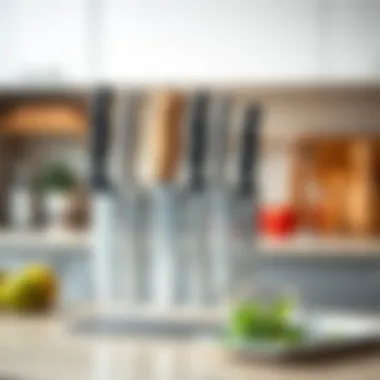
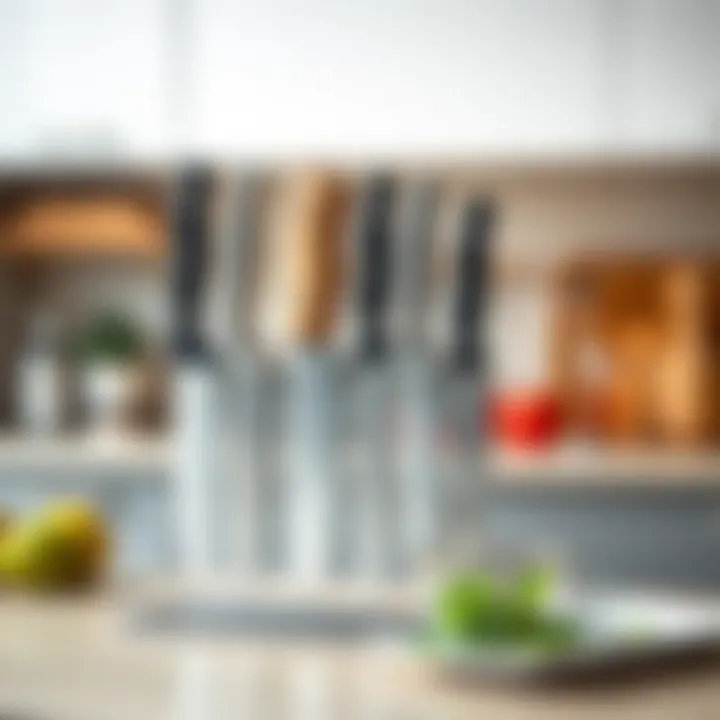
Drawer storage is another alternative that cannot be overlooked. In the quest for an organized kitchen, many homeowners are exploring cutlery trays and drawer inserts designed specifically for knives. This method offers several considerations:
- Safety: Keeping knives hidden in a drawer reduces the risk of accidents, especially in households with children.
- Protection: Knives are protected from exposure to air and dust, which can extend their lifespan and maintain cutting efficiency.
- Clutter Reduction: Drawers can conceal the cluttered look that may arise from other storage methods.
However, drawer systems have their challenges. Not every kitchen is equipped with ample drawer space, and the act of rummaging through a drawer can become cumbersome. Additionally, without clear visibility, users may find themselves frustrated when searching for knives—all the more reason why some people might still lean toward knife blocks or magnets.
In summary, the decision on knife storage solutions in the kitchen hinges upon a balance of practicality, safety, and aesthetics. Understanding the specific advantages and drawbacks of knife blocks, magnets, and drawer options empowers homeowners and designers to create a kitchen environment that suits their cooking habits and personal tastes effectively.
Professional Opinions on Metal Knife Magnets
When it comes to the nuances of kitchenware, the insights of professionals often shed light on the practicalities and aesthetics that may not be immediately apparent to the everyday user. In exploring metal knife magnets, it becomes evident that these tools serve not just a utilitarian function, but also play a pivotal role in the culinary environment. Chefs and kitchen designers provide a wealth of perspectives that highlight both the operational benefits and design considerations associated with metal knife magnets, making them a key focus of this discussion.
Insights from Chefs
Chefs, who wield knives as an extension of their craft, often have strong opinions about their storage solutions. Many chefs are vocal about preferring metal knife magnets over traditional knife blocks or drawer storage for a multitude of reasons. The first thing they mention is accessibility; having knives displayed prominently allows for easy grabbing during the heat of a culinary rush. Moments count, and a well-positioned magnet can streamline the workflow significantly.
Moreover, chefs appreciate the visibility that these magnets provide. Displaying the knives not only showcases the tools of the trade, but also allows chefs to keep an eye on their collection, assessing any wear or damage at a glance. Their sentiments echo a common theme within the culinary world: "Your tools are your assets. Take care of them and they’ll take care of you."
In professional kitchens where space is at a premium, metal knife magnets reduce countertop clutter. This organization is crucial, as it not only promotes efficiency but also enhances safety. When knives are visible and easily accessible, the chances of accidents occurring during frantic cooking sessions diminish. Additionally, the ability to mount knives on the wall can free up valuable real estate on the work surface.
Nonetheless, chefs are not without their warnings. Many highlight the importance of ensuring a strong magnetic pull. A subpar magnet that can’t hold the knife securely may lead to mishaps, potentially damaging both the blade and the surface beneath. Their feedback consistently emphasizes the need for quality and durability when choosing a metal knife magnet.
Views from Kitchen Designers
Kitchen designers provide another layer of understanding regarding metal knife magnets, particularly in terms of aesthetics and space utilization. They often take a holistic approach to kitchen design, considering not only functionality but also how different elements contribute to the overall feel of the space. From this perspective, metal knife magnets can be a focal point.
A designer might point out that these magnets offer sleek lines and contemporary flair, often enhancing the visual appeal of the kitchen. Unlike bulky knife blocks, magnets can come in various forms – from minimalist strips to elaborate wall art that incorporates knife storage. This flexibility allows homeowners to choose a design that complements their kitchen's theme, whether it's rustic, modern, or eclectic.
Kitchen designers also stress that integrating knife magnets into a kitchen layout can promote a seamless workflow. For instance, placing them near the prep area ensures that the knives are within arm's reach, optimizing kitchen ergonomics. Careful consideration of placement can turn these tools into both practical aids and artistic statements, inviting admiration and interest from guests and family alike.
However, designers caution against excessive reliance on these tools without considering the whole picture. They emphasize that a well-rounded kitchen toolset may still include other storage methods depending on the types of knives owned. A designer might recommend mixing knife magnets with drawer storage for specialized pieces, citing that flexibility and adaptability are key principles in effective kitchen design.
Sustainability Considerations
In an age where environmental awareness is gaining traction, the conversation around kitchen tools often includes a focus on sustainability. Metal knife magnets, while primarily designed for practicality and aesthetics, can also be assessed through the lens of durability and eco-friendliness. The growing emphasis on sustainable kitchen solutions speaks volumes about modern consumer preferences. Understanding these considerations not only helps in making informed choices but also aligns with a broader commitment to reduce environmental footprints in everyday products.
Eco-Friendly Material Choices
When selecting metal knife magnets, understanding their material composition can lead to better choices for sustainability-minded consumers. Magnet rods are generally made from various metal alloys, including stainless steel and aluminum, both of which have their own environmental advantages.
- Stainless Steel is renowned for its resistance to corrosion, leading to extended use without loss of functionality. Its recyclability is a significant plus; when disposed of correctly, it can be transformed into new products, alleviating pressure on raw material extraction.
- Aluminum also presents an eco-friendly option as it is lightweight yet sturdy. Like stainless steel, aluminum is infinitely recyclable, making it a preferred material for those looking to reduce waste.
By opting for knife magnets made from these materials, not only do consumers support sustainability, but they also invest in durability—lessening the need for frequent replacements and contributing to a more sustainable circular economy.
Lifespan and Environmental Impact
Understanding the lifespan of products is crucial in evaluating their environmental impact. Metal knife magnets, by nature of their sturdy construction, tend to have a long lifespan if properly cared for. Their longevity plays a vital role in reducing waste, as fewer replacements mean lower production demands and thus less energy consumption.
- Durability: A well-maintained metal knife magnet can serve its purpose for years, presenting it as a wiser purchase compared to disposable or lower-quality alternatives. This can result in significant material savings over time.
- Environmental Footprint: The carbon impact related to the manufacture of kitchen accessories shrinks considerably when consumers choose products designed for enduring use. In fact, the act of selecting longer-lasting items can be a simple yet effective way to contribute to sustainability efforts.
- Waste Reduction: By carefully considering what products to bring into their kitchens and ensuring they last, homeowners actively participate in reducing landfill contributions and pollution associated with manufacturing and shipping new products.
"Every choice we make has an impact on the environment; opting for durable and ethical kitchen tools is a step towards conscientious consumption."
Epilogue: The Future of Metal Knife Magnets in Kitchens
Metal knife magnets have undoubtedly carved out a vital role in modern kitchens. These tools blend functionality with design, creating an environment where knives are not only easily accessible but also part of the kitchen's aesthetic. As we move forward, the significance of these magnets is likely to expand, influenced by evolving trends in cooking, design, and sustainability practices.
In examining the various aspects of metal knife magnets, several elements come to the forefront. First and foremost, they encourage an organized workspace, eliminating clutter from countertops and facilitating easier access to tools. This enhances not just the efficiency of meal prep but also safety, as knives can be stored securely yet remain within reach.
Moreover, the aesthetic appeal of metal knife magnets cannot be understated. As kitchens increasingly become a social hub within homes, homeowners are looking for design elements that harmonize with the overall interior. Metal knife magnets serve this role perfectly; they boast both sleek functionality and a modern edge, transforming a simple kitchen necessity into an artful display.
Another key consideration is the ongoing advancements in materials and design. The market is seeing a trend towards eco-friendly options, such as bamboo magnets or those crafted from recycled metals, appealing to environmentally-conscious consumers. The emphasis on sustainability mirrors a broader trend in kitchen accessories, with many homeowners prioritizing responsible purchasing habits.
As new designs emerge and consumer preferences shift, metal knife magnets are set to adapt. Features like built-in knife storage slots or customizable lengths are becoming more commonplace, catering to diverse kitchen layouts and styles. In this regard, they are no longer just practical items but rather statements of style and ingenuity.
“Embracing modernization in the kitchen doesn't mean sacrificing tradition; it means blending the two in a way that complements your lifestyle.”
In summary, the future of metal knife magnets holds promise for enhanced organization, aesthetic value, and sustainable choices. Their evolution will continue to reflect not only the changing dimensions of culinary arts but also the preferences and values of the modern homeowner. As kitchens evolve into personalized spaces that reflect individual taste and style, metal knife magnets will remain a compelling choice for both functionality and artistic expression.
Summary of Key Takeaways
- Enhanced Organization: Metal knife magnets help maintain an organized kitchen space, minimizing clutter on countertops.
- Aesthetic Appeal: They serve as a modern design feature, making knives a visible part of kitchen decor.
- Safety and Accessibility: Stored knives are secured safely while remaining easily reachable for cooking tasks.
- Sustainable Options: Growing demand for eco-friendly materials is shaping the future of metal knife magnets.
- Adaptability: Innovations in design and materials suggest a flexible future that caters to evolving consumer tastes.
Predictions for Upcoming Trends
- Customizable Designs: Expect to see more customizable knife magnets that homeowners can tailor to fit their unique kitchen aesthetics.
- Increased Focus on Sustainability: As consumers become more eco-conscious, magnets made from recycled or sustainable materials will likely gain traction.
- Tech Integration: Future options may incorporate technology, such as magnetic surfaces that can charge devices or signal notifications.
- Varied Material Use: Innovative materials, including bioplastics or composites, could redefine the market space, introducing variety in terms of durability and eco-friendliness.
- Widening the Utility: Beyond knives, we may see magnetic strips designed for holding other kitchen tools, enhancing their versatility further.







